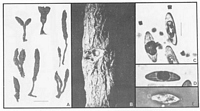|
 Xylaria zealandica Xylaria zealandica
BiostatusPresent in region - Indigenous. Endemic
Images (click to enlarge)
Caption: Fig. 13 Xylaria zealandica A, Stromata. B, Stromal surface. C, Ascal ring and ascospores
(Melzer's reagent). D, Ascospore with germ slit (Melzer's reagent). E, Young ascospore with
basal cellular appendage (arrow, Melzer's reagent, dark field p |
Description: Stromata: Stromata upright (taller than broad); stipitate; 30-40 mm tall; 2-3 mm diam.; perithecia not visible, or inconspicuous; ostioles lower than or more or less equal to stromatal surface; stromatal surface with peeling or flaking scales; blackish; KOH-extractable pigments lacking; tissue below perithecia conspicuous, essentially homogeneous, white.
Perithecia: Perithecia more or less globose; 0.5-0.7 mm diam.
Asci: Amyloid ring higher than broad.
Ascospores: Ascospores 23-28 µm long; 8-10 µm wide; brown; 0-septate; in side view more or less equilateral, or inequilateral, flattened on one side, not curved; in face view elliptic; ends broadly rounded, or narrowly rounded. Germ slit straight, spore-length; on flattened side of spore. Perispore indehiscent in 10% KOH.
Article: Rogers, J.D.; Samuels, G.J. (1987) [1986]. Ascomycetes of New Zealand 8. Xylaria. New Zealand Journal of Botany 24(4): 615-650 (http://www.rsnz.org/publish/abstracts.php).
Description: Stromata cylindrical to cylindrical-clavate to conical, usually with a short acute umbo
extending beyond fertile portion, with abruptly narrowed stipes making up to one-half of
the total length, 4 cm high x 2-3 mm broad. Immature stromata in good condition not
observed. Mature stromata dull blackish-brown to blackish. Perithecia 500-700 µm diam.;
ostioles umbilicate, inconspicuous. Stipes glabrous, or nearly so, and striate. Stromata
roughened by remnants of peeling layer. Asci 8-spored, cylindrical, long-stipitate, but in
poor condition in material examined. Apical ring of ascus J +, urn-shaped, 4.5 µm high x 3
µm broad. Ascospores (22-)23-28(-31) x (7.5-)8-9 µm, brown, one-celled or with
inconspicuous cellular appendage (primary appendage) on one end, with straight to
undulate germ slit slightly less than spore length, parallel to long axis of the ascospore.
Habitat: HABITAT: On dead wood.
Distribution: DISTRIBUTION: NORTH ISLAND: Wellington.
Notes: Cooke (1879) described X. zealandica from one specimen collected in
Wellington by Travers. Ascospores were published as 32-35 x 10 µm. We examined the
type specimen [New Zealand, Travers (K)] in 1979 and it strongly resembles X. apiculala.
A few ascospores were measured and were 22-27 x 7-9 µm. In order to check these
measurements we recently asked Dr Brian Spooner (K) to make additional measurements
of ascospores. The overall size range of 18 ascospores was 21.5-27.5(-29) x (7.5-)8.0-10.0(-11.0) µm.
This range agrees well with unpublished data of Dr R.W.G. Dennis
generously supplied by Dr Spooner.
The status of X. zealandica is uncertain. It seems very probable that Cooke gave an
incorrect size range for ascospores from the type specimen. Although the ascospores of the
type specimen and our material are somewhat larger than is usually encountered in X.
apiculata, the ranges greatly overlap. The possibility exists, however, that further collecting
and culturing will reinforce the existence of X. zealandica as a distinct species. Thus, we
tentatively accept X. zealandica herein.
|